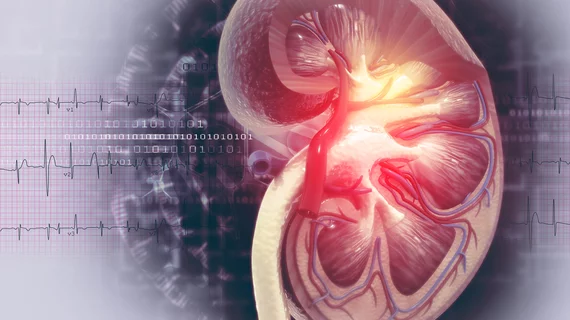CKD linked to development of aortic stenosis, even at milder stages
Chronic kidney disease (CKD), even in its moderate stages, is associated with an increased risk of aortic stenosis (AS), according to research published ahead of print in the Journal of the American College of Cardiology.
A team led by Georgios Vavilis, MD, of the Karolinska Institute in Stockholm, assessed a link in their study that’s remained tenuous over the years: the relationship between CKD and heart disease.
“Individuals with moderate to severe CKD have a high prevalence of atherosclerotic risk factors, cardiovascular disease and disturbances in bone-mineral metabolism that are well-established promoters of cardiovascular calcification,” Vavilis and co-authors wrote in JACC. “Despite these potential disease mechanisms, it remains unknown whether the risk of developing AS is associated with the degree of kidney dysfunction, including individuals who are not undergoing dialysis.
“Knowing whether this association exists would be important for physicians, researchers and health policymakers because CKD is a growing public health problem.”
Vavilis and his team drew from the SCREAM (Stockholm Creatinine Measurements) cohort for their work, including 1.1 million Swedish citizens without a prior diagnosis of AS. The researchers calculated estimated glomerular filtration rate (eGFR)—in the study, they considered CKD as anything under 60 ml/min/1.73m2—from serum creatinine and used clinical diagnostic codes to determine AS incidence during five years of follow-up.
Six percent of the study population presented with CKD, the authors reported, and the average eGFR for the entire cohort was 96 ml/min/1.73m2. By the time the study wrapped, 0.5 percent of individuals had developed CKD, at an incident rate of 1.13 per 1,000 person-years.
Compared with subjects who recorded an eGFR greater than 90 ml/min/1.73m2, lower eGFR strata were associated with higher hazards of aortic stenosis. The relationships were as follows:
- eGFR of 60 to 90: 14 percent increased risk of AS
- eGFR of 45 to 59: 17 percent increased risk of AS
- eGFR of 30 to 44: 22 percent increased risk of AS
- eGFR below 30: 56 percent increased risk of AS
Individuals with eGFR of less than or equal to 44 ml/min/1.73m2 hovered around a 20 percent risk of AS when excluding both events within two years of baseline and participants with heart failure, Vavilis et al. said.
“This is the first study to suggest that kidney dysfunction among non-dialysis-dependent individuals is independently associated with the risk of developing AS,” the authors wrote. “The risk increases with lower eGFR, a finding suggesting a ‘dose-response’ association, and remains present after adjusting for covariates.”
Vavilis and colleagues said that even after “extensive” sensitivity analyses, kidney dysfunction remained associated with development of AS.
“The precise mechanism of the finding in this study of an association between kidney dysfunction and AS is still unknown,” they wrote. “The mechanisms behind lesser degrees of kidney dysfunction and AS remain and need to be fully explored.”

